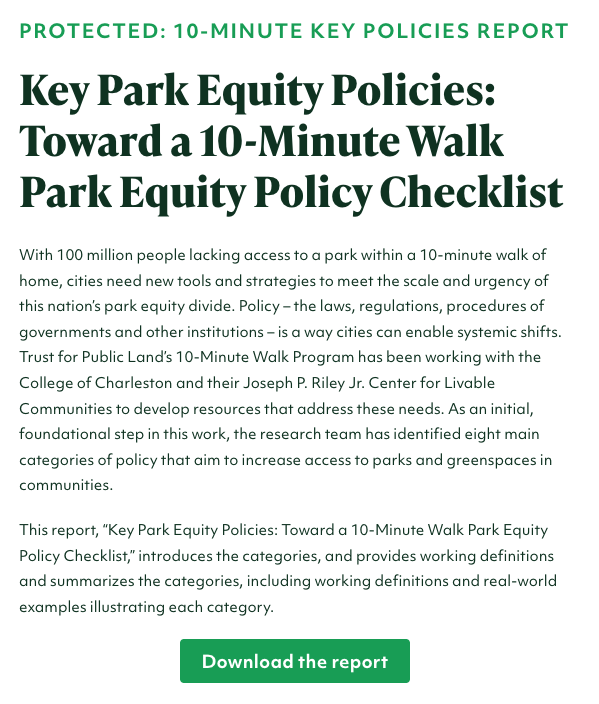Lexington, Kentucky, may never shed the moniker “horse capital of the world.” But a new movement is underway that could earn it another superlative: park equity champion. The city is aggressively tackling its park equity gap through the same means that created it—policy. More specifically, zoning policy.
One-third of Americans, including 28 million children, lack safe, easy access to a park within a 10-minute walk of home. Urge your senators to allocate funding to create parks and enhance outdoor recreational opportunities by championing the Outdoors for All Act today!

We’re on a mission to change that with our 10-Minute Walk® program, as we work hand in hand with cities and their mayors to generate investments in and access to parks and public land that benefit communities across the country. Learn more about our work with mayors and their pledges to bring everyone in their districts within a 10-minute walk of a park by 2050.
“The sleepy backwater of the policy world,” according to M. Nolan Gray, author of Arbitrary Lines: How Zoning Broke the American City and How to Fix It, zoning reform has the potential to correct ongoing crises of housing affordability, inequality, segregation, and sprawl. It’s true across the country and especially in Lexington, which has been attracting residents and businesses at a breakneck pace thanks to high-quality schools, low cost of living, and signature parks and greenspaces.
But this rapid growth isn’t without its challenges. The current pace of development in Lexington and many other U.S. cities is exceeding the acquisition of parkland, which could potentially widen the gap between those who have access to high quality parks and those who don’t.
Lexington city leaders and partners are envisioning a new path to park equity as part of their Imagine Lexington comprehensive plan, which includes a goal of “increasing the population served within a 10-minute walk of a neighborhood park through development of existing parkland, new parks in growing areas (including developer contributions), and improved access to existing parks.”
As part of its plan and through its “Rethink Open Space” initiative, the city is reshaping zoning policy to ensure future development supports equitable access for neighborhoods that, in the past, have been left behind when it comes to parks.
Now, developers are required to provide and maintain intentionally designed and equitably distributed common areas in new projects. The zoning changes also provide minimum standards for the development of common areas, ensuring that they’re developed to be accessible, functional, and meet the needs of the residents they serve. While these new common areas are not required to be dedicated as public parks, they can provide many similar benefits, albeit at a smaller scale.
“Lexington recognizes the need to increase access to open spaces where people can interact with their neighbors and enjoy the benefits of close-to-home green space,” says Valerie Friedmann, senior planner and green space planner for the City of Lexington Division of Planning. “But unfortunately, over the last several decades, we’ve seen a decrease in the construction of neighborhood- scale parks. Our updated zoning regulations are a first step toward reversing this trend, and we’re already seeing greener, more community-focused open spaces in new development. Our land-use policies now ensure community open space is built in from day one, and that is one approach we are taking to closing our park equity gap.”
“Boring though it may be, zoning has real-world effects that are dire.”
– M. Nolan Gray, author, Arbitrary Lines: How Zoning Broke the American City and How to Fix It
As in many cities, Lexington’s park inequities are rooted in a long history of policy decisions—including zoning ordinances—that supported disinvestment of neighborhoods based largely on the racial or socioeconomic makeup of residents. From the early post-Civil War period through the mid-1900s, many neighborhoods segregated residents by race.
Policies that prevented Black residents from buying property in certain neighborhoods, for example, or that displaced Black residents in favor of development effectively directed investment toward White neighborhoods and away from Black ones. While these policies were made illegal by the end of the 1960s, their lingering effects are still present today.
In more recent years, a lack of policies that support public input and equitable funding have further contributed to the park equity gap. These issues have played out across the U.S., with historic and contemporary policies (or lack thereof) creating and exacerbating the park equity gap.
Which Policies Will Move The Needle?
In 2021, with a forward commitment to equity, TPL added equity measurements into our annual ParkScore® survey as a way to help cities understand their current park equity conditions, establish baselines, and measure progress.
While policy change sounds like a simple solution, we know it’s not. Many of the changes that are needed to improve Lexington’s or any city’s park equity score require long-term solutions to undo the root causes of disparities in access to high-quality parks. The TPL 10-Minute Walk program is taking the long view.
We’ve heard from our more than 300 10-Minute Walk mayors, local leaders, and decisionmakers that they need more clarity, resources, and support to understand which policies are right for their cities.
In partnership with a multidisciplinary research team at the College of Charleston’s Joseph P. Riley Jr. Center for Livable Communities, we’re creating a framework of eight policy categories—Parks Needs Assessments, Community Engagement, Public Finance, Maintenance, Shared Use, Land Use, Connectivity, and Externalities and Anti-Displacement—aimed at increasing park access. Currently, the team is using the framework to study park policies in cities around the U.S., with trends and promising models to be identified in a forthcoming report.
 “We are hearing enthusiasm for this project from the city leaders we have talked to over the course of this project,” says Kendra Stewart, professor of political science and director of the Joseph P Riley Jr. Center for Livable Communities. “Many cities want to increase park access and reduce park inequity, and they are looking for options that best meet the needs of their own communities. This research will help cities navigate the complex landscape of park policy by organizing policy approaches and showcasing examples from cities across the United States.”
“We are hearing enthusiasm for this project from the city leaders we have talked to over the course of this project,” says Kendra Stewart, professor of political science and director of the Joseph P Riley Jr. Center for Livable Communities. “Many cities want to increase park access and reduce park inequity, and they are looking for options that best meet the needs of their own communities. This research will help cities navigate the complex landscape of park policy by organizing policy approaches and showcasing examples from cities across the United States.”
In addition to the framework-guided research, TPL has selected a cohort of six cities, including Lexington, to test local, on-the-ground solutions through a first of its kind accelerator program. Trust for Public Land, cross-sector partners, and other experts will help the cities field-test policy strategies in order to unravel deeply rooted inequities.
Findings from the policy framework survey and the accelerator program will support scaling the model to additional cities and will serve as a foundation for a forthcoming “Park Equity Policy Agenda” and other resources, such as model policies and direct assistance . This effort will illuminate the current nationwide park policy landscape, and TPL will eventually create a menu of actionable, data-supported policy options for cities.
In Lexington, partners at CivicLex and SeedLeaf, a community gardening organization, are tapping into Trust for Public Land’s 10-Minute Walk Park Equity Accelerator program to help them realize their vision.
Key to the success of the Imagine Lexington plan and the zoning reform initiative is strong community engagement, which TPL’s Common Ground Framework defines as “the practice of building relationships with key community members in ways that earn trust, legitimize community voices, nurture grassroots collaboration and stewardship, build community capacity, and center the community in decision-making on issues that affect community members’ daily lives and environments.”
By bringing together residents and members of local government to engage in conversations about parks and to make sure that the decisions about park improvements, development, and programming meet the needs of residents, Lexington is taking steps to reverse the impact of decades of inequitable investment.
“In Lexington, like most places, important policy decisions that affect many are often influenced by small, informed, and well-connected groups,” said Megan Gulla, Director of Programs at CivicLEx, one of the Park Equity Accelerator partners. “With TPL’s support through the Park Equity Accelerator, Lexington, and communities around the country are creating more accessible and inclusive mechanisms for resident engagement with, and involvement in, policy and decision-making processes related to parks and green spaces. It’s neither quick nor easy work, but it’s essential if we want to build communities that meet the needs of all residents.”
Download: Key Park Equity Policies: Toward a 10-Minute Walk Park Equity Policy Checklist

Donate to become a member, and you’ll receive a subscription to Land&People magazine, our biannual publication featuring exclusive, inspiring stories about our work connecting everyone to the outdoors.

